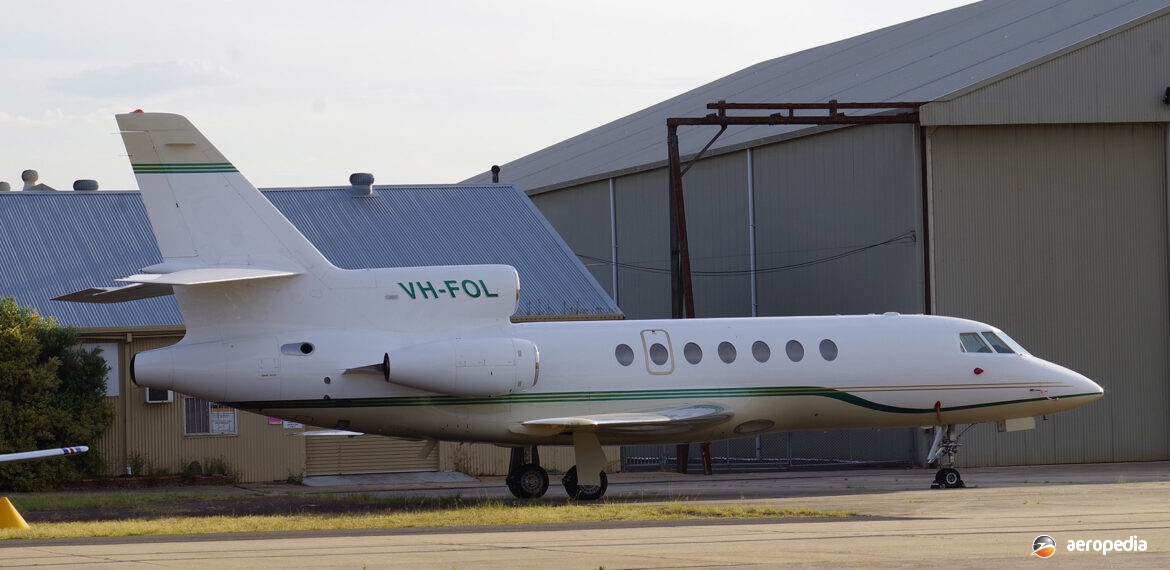Photograph:
Dassault-Breguet Falcon 50 VH-FOL (c/n 159) at Bankstown, NSW in March 2016 (David C Eyre)
Country of origin:
France
Description:
Business and executive jet
Power Plant:
Three 3,700 lbst Garrett AiResearch TFE 731-3 turbofans
Specifications:
- Wingspan: 18.86 m (61 ft 10½ in)
- Length: 18.52 m (60 ft 9 in)
- Height: 6.97 m (22 ft 10 3/8 in)
- Wing area: 46.83 m² (504.13 sq ft)
- Max cruising speed at 10,060 m (33,000 ft): 880 km/h (547 mph)
- Economical cruising speed at 11,275 m (37,000 ft): 792 km/h (495 mph)
- Service ceiling: 13,716 m (45,000 ft)
- Range with eight passengers and 45 mins reserve: 6,578 km (4,088 miles)
- Range at max cruising speed: 4,447 km (2,764 miles)
- Empty weight: 9,000 kg (19,840 lb)
- Loaded weight: 17,600 kg (38,800 lb)
History:
The Dassault-Breguet Falcon 50 was a larger development of the Mystere/Falcon 20 series of business and executive aircraft. The prototype was flown for the first time on 7 November 1976, followed by the second prototype on 18 February 1978. By the beginning of 1981, 40 examples had been delivered and production was proceeding at a rate of four aircraft per month.
After its first flight the wing of the prototype was modified to incorporate a supercritical design but possessing the same planform as the original wing. Like the Falcon 100 and 200 series, the type was known as the Mystere on the French and European markets, and as the Falcon on the American market. With similar capacity to the Falcon 20, the Falcon 50 had appreciably greater range, having true overseas capability and, because of the three engines, did not have the usual problems associated with twin-engine aircraft making long-distance flights over water. In fact, an aircraft of this type on 31 March 1979 established a number of world records in the C-1H Class during a non-stop ferry flight from the manufacturer’s facility at Bordeaux in France to Teterbero, New Jersey in the USA.
Accommodation was normally provided for a crew of two with seating for six to twelve passengers, depending on customer requirement. A toilet was situated at the rear of the cabin, as was a baggage compartment. Thrust reversal was installed on the centre engine only.
The first Falcon 50 seen in this region was N50J, which made an Australian demonstration tour in late 1983 for Hawker Pacific. In March 1984 the first of the type arrived for an Australian owner, this being VH-SFJ (c/n 123) which had originally been built for the French President but, because of a change in Government policy, became available for sale on completion. This aircraft entered service in Western Australia for Executive Air West but was exported in May 1987 as N211EF.
Others which have operated in this area have included: VH-PDJ (c/n 176) operated by Ariadne Australia from September 1987 to March 1988 when it was exported as N157SP and VH-PPF (c/n 187) operated by Paspaley Pearling Company from August 1995 to February 2004 when it was exported as N187PN. On 29 May 2017 a Falcon 50 became VH-FJQ² (c/n 252) owned and operated by Falcon 50 Pty Ltd of Camden, NSW.
A number of overseas registered Falcon 50s have visited over the years, one of which was based in Australia for a period, this being N235Y (c/n 185) operated by Daikyo from Cairns, QLD from April to August 1990 before returning to the United States.

